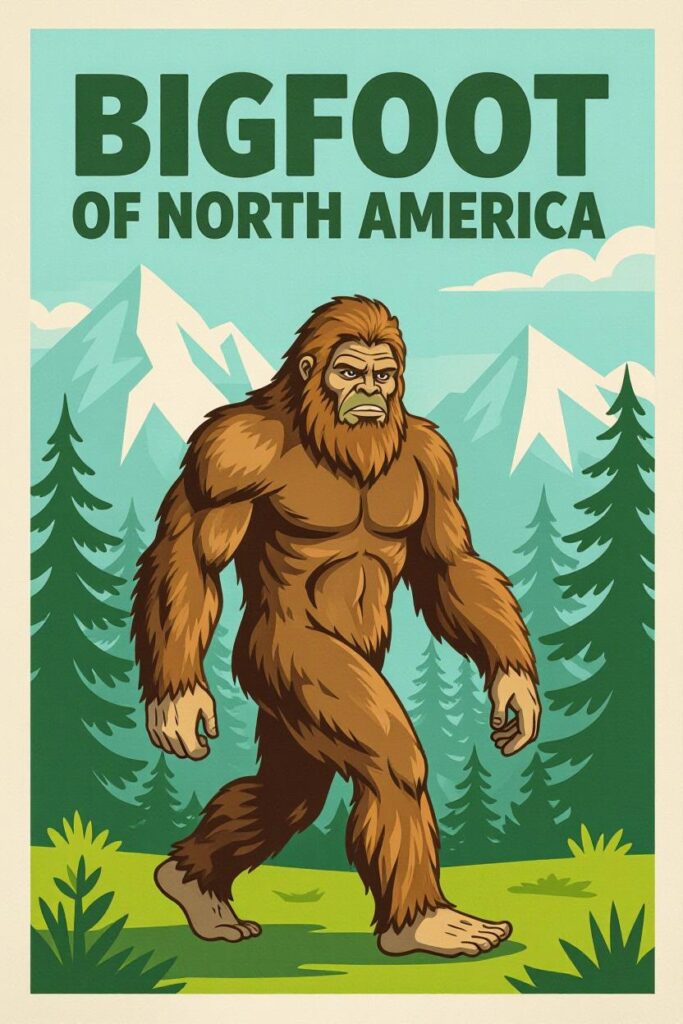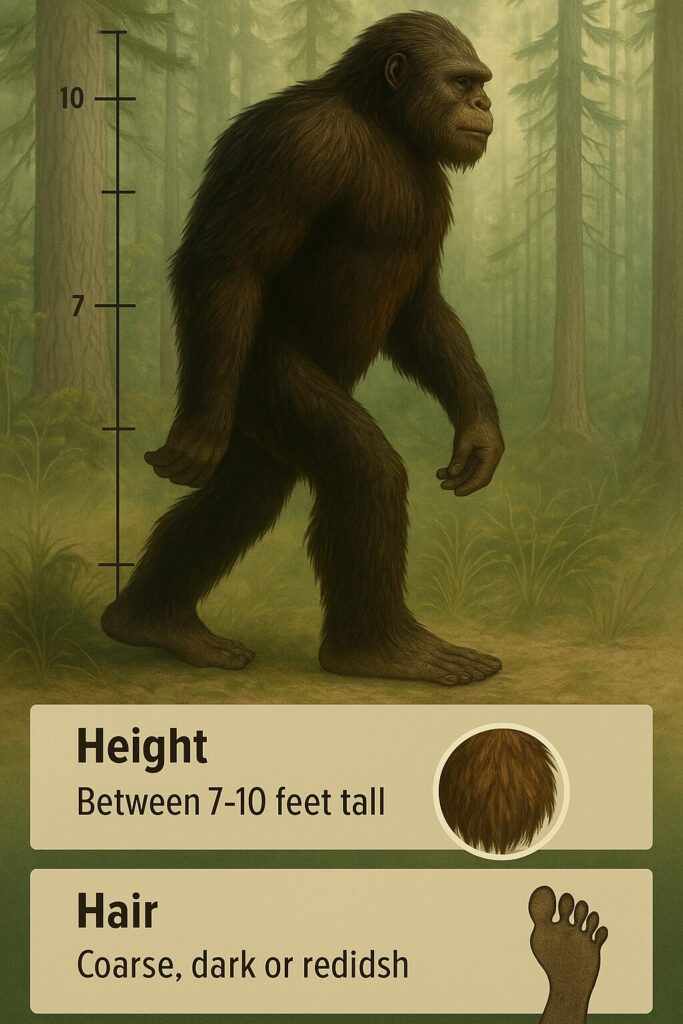Discover the common physical traits of Bigfoot in North America, from towering height and massive footprints to hair color variations and reported facial features. Explore eyewitness accounts and folklore that describe this legendary cryptid.
Contents
- Introduction
- The Overall Size and Build of Bigfoot
- Footprints and Tracks
- Hair and Fur Descriptions
- Facial Features
- Arms, Hands, and Legs
- Distinctive Odor
- Sound and Vocal Characteristics
- Regional Variations Across North America
- Why These Characteristics Matter
- Conclusion
- Final Thoughts
- Frequently Asked Questions About Bigfoot’s Physical Characteristics
- References
- Paraghosts Blog
Introduction

Bigfoot, also known as Sasquatch, is one of the most widely discussed cryptids in the world.
For centuries, Indigenous traditions, frontier folklore, and modern eyewitness reports have painted a picture of a towering, elusive figure that roams the forests, mountains, and swamps of North America.
Whether people see it in the dense Pacific Northwest, the swamps of Florida, or the Appalachian backwoods, the descriptions share striking similarities.
These consistent physical traits have built a kind of “biological profile” for Bigfoot.
While no scientific specimen has ever been captured, thousands of accounts and alleged physical evidence, like plaster cast footprints, hair samples, and even controversial photographs and films, give us a foundation for understanding what people believe they have encountered.
In this detailed article, we will explore Bigfoot’s most reported physical characteristics, breaking down everything from its massive size and muscular build to its hair color, footprints, and even its scent.
Each section will provide a deeper look at the traits described across North America, and why they matter in the ongoing search for this mysterious creature.
The Overall Size and Build of Bigfoot
Height and Stature
One of the most defining features of Bigfoot is its enormous height. Eyewitnesses across North America describe it as standing anywhere from 7 to 10 feet tall, with some rare accounts mentioning beings as large as 12 feet.
These estimates are based on comparisons with surrounding objects such as trees, cars, or fence posts.
- Pacific Northwest reports often describe the tallest and bulkiest Bigfoot sightings, sometimes pushing 10 feet.
- Appalachian sightings usually report creatures between 7 and 8 feet tall, though a few larger ones have been noted.
- Southern encounters often describe slightly smaller figures, sometimes between 6 and 7 feet, which may be regional variants or juveniles.
Its stature is usually upright and human-like, but bulkier, with a natural, relaxed stance that makes it seem comfortable moving on two legs. Unlike humans, its center of gravity appears lower, which may contribute to its smooth, gliding stride.
Muscular Frame
Bigfoot is almost always described as extremely muscular and powerful, with witnesses often comparing it to a professional bodybuilder or powerlifter. Its chest and shoulders are reported as incredibly broad, with some accounts describing shoulder spans of 3 to 4 feet wide.
- Arms: Its arms are said to be disproportionately long, sometimes reaching to its knees. This trait is commonly reported across all regions, giving the impression of great strength and ape-like proportions.
- Chest: A barrel-shaped chest is often noted, with the appearance of massive lung capacity. This may explain its ability to produce the loud howls and roars sometimes recorded in wilderness areas.
- Torso: Witnesses often describe its torso as covered in dense hair but shaped like that of a human athlete, with defined muscles visible under the fur.
These descriptions suggest a being capable of surviving in harsh wilderness conditions, with raw strength that far surpasses that of a human.
Footprints and Tracks
Size and Shape
The footprints are perhaps the most famous evidence associated with Bigfoot, and they are also the reason for its name. These tracks often measure between 15 and 24 inches long and 7 to 10 inches wide, far exceeding the size of human feet.
- Most prints show five distinct toes, similar to human feet, though sometimes wider or flatter.
- Some tracks include dermal ridges, the same kind of skin patterns found on human feet and fingers.
- In certain cases, tracks have shown signs of midtarsal breaks, a joint structure more common in non-human primates, suggesting a different walking pattern than humans.
Variations Across Sightings
While most casts show human-like prints, variations exist:
- Splayed toes: Some prints show toes spread out, possibly from walking barefoot in rugged terrain.
- Flat arches: Unlike humans, many tracks lack a pronounced arch, showing a flatter structure that may help with stability in uneven environments.
- Unusual depth: Witnesses often note that the prints sink much deeper into the soil than human tracks, suggesting immense weight.
Famous Trackways
Some of the most well-known prints include:
- Bluff Creek, California (1967): Associated with the Patterson-Gimlin film, these prints were cast and studied extensively.
- Grays Harbor, Washington: Numerous casts taken in the 1980s show consistent size and toe structure.
- Ohio and Midwest sightings: Tracks often found in river valleys and muddy creek beds, matching the large dimensions described in other states.
Hair and Fur Descriptions
Color Variations
Hair color is one of the most consistent characteristics reported by witnesses, though it varies by region and individual.
- Dark brown or black: Most common in the Pacific Northwest.
- Reddish-brown or auburn: Frequently reported in the South and Midwest.
- Gray or silver-tinted: Seen in older individuals, suggesting aging similar to humans.
- Blonde or light shades: Rare, but occasionally reported in northern regions.
Texture and Appearance
Witnesses consistently describe Bigfoot’s hair as coarse, thick, and animal-like. In some cases, it appears matted and unkempt, while others describe it as sleek and oily, possibly due to environmental conditions.
- Length: Usually reported between 2 to 6 inches, though some describe longer hair around the head and shoulders, almost like a mane.
- Coverage: The body is almost entirely covered, with exceptions around the face, palms, and soles of the feet.
- Seasonal shedding: Some believe that Bigfoot may shed or change coat thickness depending on the climate, much like other mammals.
Facial Features
General Appearance
Witnesses often describe Bigfoot’s face as a blend between human and ape-like features.
- Forehead: Heavy brow ridges, often shadowing the eyes.
- Eyes: Deep-set, sometimes described as glowing red or amber, especially in low light.
- Nose: Wide and flat, similar to a gorilla’s nose rather than a human’s narrow bridge.
- Mouth: Broad, with thin lips. Some reports mention visible, flat teeth when the mouth is open.
- Skin: Usually dark, ranging from leathery brown to gray-black, often visible beneath thinner patches of hair.
Expressions and Intelligence
Many witnesses claim that Bigfoot’s face is capable of expressing emotion. Descriptions include looks of curiosity, annoyance, or even calmness. These details suggest intelligence, with some believing it demonstrates awareness similar to humans.
Arms, Hands, and Legs
Arm Length and Strength
Bigfoot’s arms are one of its most striking features. They appear unusually long for its body, with hands often reaching the knees. Reports suggest arms that are incredibly muscular, capable of throwing rocks, breaking tree branches, and even lifting logs.
Hands
Bigfoot’s hands are described as massive, resembling oversized human hands with five fingers. Some accounts mention long, thick nails or dirty claw-like features, but most describe them as blunt and human-like.
- Finger width: Extremely wide, suggesting immense grip strength.
- Palm size: Large enough to leave clear impressions in soft ground.
- Functionality: Witnesses claim Bigfoot has the dexterity to manipulate objects, throw stones, or peel bark from trees.
Legs and Movement
Bigfoot’s legs are thick and muscular, built for power and endurance. Its gait is often described as unique:
- Smooth stride: Rather than bouncing like a human walk, Bigfoot appears to glide, moving with little vertical motion.
- Stride length: Reported tracks often show strides of 4 to 6 feet between steps, far greater than human stride length.
- Speed: Witnesses frequently describe it moving incredibly fast, covering ground effortlessly despite its bulk.
Distinctive Odor
One of the most unusual physical traits reported is the strong odor associated with Bigfoot encounters. Witnesses describe it as foul and overwhelming, often compared to:
- Rotting garbage
- Wet dog or skunk
- Sulfur or ammonia
This odor is often noticed before a visual sighting, leading some to believe Bigfoot uses scent as a defense mechanism or communication signal.
Sound and Vocal Characteristics
Although not purely physical, vocalizations are often included in descriptions of Bigfoot. Witnesses describe an incredible range of sounds:
- Howls and roars: Deep, resonant calls that can be heard from miles away.
- Wood knocks: Loud banging sounds, believed to be a form of communication.
- Chattering: Some claim to have heard speech-like gibberish, famously captured in the “Sierra Sounds.”
- Growls and screams: Often associated with aggressive or territorial encounters.
These sounds further highlight Bigfoot’s uniqueness, as they differ from known wildlife calls.
Regional Variations Across North America
Pacific Northwest
- Size: Larger, bulkier, often 9 to 10 feet tall.
- Hair: Dark brown or black.
- Behavior: More elusive, often seen near mountainous forests.
Southern States (Skunk Ape)
- Size: Smaller, often 6 to 8 feet.
- Hair: Reddish-brown.
- Smell: Stronger odor reported, especially in swampy areas.
Midwest and Appalachian Regions
- Size: Medium build, 7 to 9 feet.
- Hair: Reddish-brown to auburn.
- Temperament: More aggressive encounters, often near rural communities.
Why These Characteristics Matter
The consistency of these reported physical traits across thousands of accounts is one of the strongest arguments for Bigfoot’s possible existence.
Witnesses from different regions and time periods describe the same details, often without prior knowledge of other reports.
This level of consistency strengthens the case that people may be encountering the same type of creature.
Conclusion
Bigfoot’s physical characteristics, described in detail by eyewitnesses for decades, form one of the most compelling cryptid profiles in the world.
From its towering height and massive footprints to its thick hair and expressive face, the creature’s reported traits are remarkably consistent.
Final Thoughts
Bigfoot remains an unsolved mystery. Whether it is a flesh-and-blood primate, a cultural archetype, or something beyond our understanding, the physical descriptions tell a story that refuses to fade.
These traits are more than folklore, they are part of a living tradition of encounters that continue to fascinate people across North America.
As long as witnesses keep reporting what they see, the legend of Bigfoot will remain alive, driving both scientific curiosity and cultural imagination.

Frequently Asked Questions About Bigfoot’s Physical Characteristics
1. How tall is Bigfoot supposed to be?
Most eyewitnesses describe Bigfoot as standing between 7 and 10 feet tall, though rare accounts suggest heights of up to 12 feet. The size often depends on the region where it is reported. For example, Bigfoot in the Pacific Northwest is usually described as taller and bulkier, while creatures seen in the Southern United States like the Skunk Ape tend to be slightly smaller, averaging 6 to 8 feet.
This towering height is one of the most consistent details across reports. People often estimate its size by comparing it to nearby trees, fence posts, or vehicles. The average height range of 8 to 9 feet makes Bigfoot significantly larger than any human and taller than known great apes such as gorillas.
2. What does Bigfoot’s face look like?
Bigfoot’s face is often described as a blend between human and ape-like features. Witnesses commonly report:
- A prominent brow ridge that casts deep shadows over the eyes.
- Eyes that are deep-set, sometimes glowing amber or red when caught in headlights or moonlight.
- A wide, flat nose, much more like a gorilla’s nose than a human’s.
- A large mouth with thin lips and sometimes visible, flat teeth.
- Skin color that ranges from dark gray to leathery brown, often visible beneath thinner patches of hair.
Many people claim Bigfoot’s facial expressions suggest intelligence. Some witnesses say they felt the creature was studying them, while others describe looks of anger, curiosity, or even calmness.
3. What kind of hair or fur does Bigfoot have?
Bigfoot is almost always reported as being covered in thick, coarse hair across most of its body, except for the face, palms, and soles of the feet. The hair is usually described as 2 to 6 inches long, though some witnesses note longer strands around the head, shoulders, or back.
The hair color varies by region and individual:
- Dark brown or black is most common in the Pacific Northwest.
- Reddish-brown or auburn is frequently reported in the Midwest and Appalachian regions.
- Gray or silver-tinted coats appear on older individuals, leading some to believe they age like humans.
- Blonde or light-colored Bigfoot are rarely reported but appear in northern areas.
The texture is said to be coarse, rough, and sometimes oily or matted, similar to animal fur. Some speculate that Bigfoot may shed its hair or grow a thicker coat depending on the season, much like other mammals in the wild.
4. What do Bigfoot’s footprints look like?
Bigfoot footprints are one of the most famous pieces of alleged physical evidence. They are typically described as:
- Measuring 15 to 24 inches long and 7 to 10 inches wide.
- Showing five distinct toes, like a human footprint but on a much larger scale.
- Having flat arches, unlike the curved arch of most human feet.
- Sometimes displaying dermal ridges, the fine skin patterns similar to fingerprints.
- Often sunk deeply into mud, sand, or snow, suggesting immense weight.
Some casts even show a midtarsal break, a trait found in apes that allows for flexible movement in rugged environments. This unique characteristic is often cited by researchers as evidence that Bigfoot’s locomotion differs from human walking.
5. Does Bigfoot have a bad smell?
Yes, one of the most unusual details reported by eyewitnesses is the strong odor associated with Bigfoot. People often describe it as an overpowering stench that lingers even after the creature has left the area.
The odor is usually compared to:
- Rotting garbage
- Wet dog or skunk
- Sulfur, ammonia, or decay
This smell is often noticed before an actual sighting, leading some researchers to believe Bigfoot uses it as a defense mechanism or as a way of marking its territory. The Skunk Ape of Florida, a regional variation of Bigfoot, is especially associated with this pungent odor.
6. How does Bigfoot move?
Witnesses consistently report that Bigfoot moves in a smooth, gliding stride rather than the up-and-down bounce of a human walk. Its gait looks unusual and has been studied in detail using alleged film footage, such as the famous Patterson-Gimlin film of 1967.
Distinctive movement traits include:
- Stride length of 4 to 6 feet between steps, much longer than a human stride.
- Arms swinging naturally at its sides, sometimes reaching near the knees.
- Speed and agility surprising for its size, with accounts of it running swiftly through dense forests.
- Ability to move silently, despite its massive weight, which adds to its mystery.
This unique stride, combined with its long legs and powerful frame, makes it capable of covering large distances quickly and efficiently.
7. Do different regions describe Bigfoot differently?
Yes, regional differences in reports suggest that Bigfoot may have variations across North America.
- Pacific Northwest (Washington, Oregon, British Columbia): Bigfoot is described as larger, darker, and bulkier, often 9 to 10 feet tall.
- Southern States (Florida, Louisiana, Texas): Known as the Skunk Ape, usually smaller (6 to 8 feet tall), with reddish-brown hair and a much stronger odor.
- Midwest and Appalachians (Ohio, Kentucky, West Virginia): Often reported as reddish-brown in color, more aggressive, and commonly encountered near rural areas.
These differences may reflect environmental adaptation, different species or subspecies, or simply variations in witness interpretation.
8. Why are Bigfoot’s physical characteristics important?
The physical descriptions of Bigfoot matter because they provide consistency across thousands of sightings. People from different regions and backgrounds describe the same traits — massive height, broad shoulders, long arms, large footprints, thick hair, and human-ape facial features.
This consistency suggests that witnesses may be seeing the same type of creature, rather than each encounter being random misidentification. By studying these characteristics, researchers can:
- Compare reports across regions for similarities and differences.
- Analyze footprints and physical evidence for anatomical details.
- Build a profile of Bigfoot that can guide future investigations.
Ultimately, the descriptions help keep the mystery alive and drive scientific curiosity, cultural interest, and paranormal research.
More Articles From Paraghosts
- Is Bigfoot Real? The Truth Behind the Most Convincing Sightings
- How AI is Revolutionizing Paranormal Investigations in 2025
References
Bigfoot Wikipedia – Explore Height, Build, Hair, and Footprint Details. A comprehensive encyclopedic overview of Bigfoot, also known as Sasquatch, covering descriptions of its size, muscular build, hair, footprints, and visual representations across North America.
Tracking the Legend of Bigfoot (Arizona State Museum) – Footprints & Origins Explained. From the Arizona State Museum, this page dives into the early footprint casts tied to the legend and the cultural roots of Bigfoot, including Native American traditions and the story behind the famous Bluff Creek tracks.
Paraghosts Blog
Welcome to Paraghosts.com, your number one source for everything paranormal.
Whether you’re fascinated by ghost sightings, haunted locations, Bigfoot encounters, or spirit communication, Paraghosts delivers in-depth guides, real investigations, expert articles, and eerie evidence from the field.
This is where curiosity meets credibility, and where believers and skeptics alike explore the unknown.
If you’re ready to dig deeper into the strange, the unexplained, and the spine-chilling truths of the paranormal world, you’re in the right place.

- Paranormal Investigators Guide: Debunking vs Proving Hauntings - November 22, 2025
- True paranormal stories from abandoned hospitals - November 22, 2025
- What Is the Butterfly Effect in Simple Terms for Beginners? - November 9, 2025


